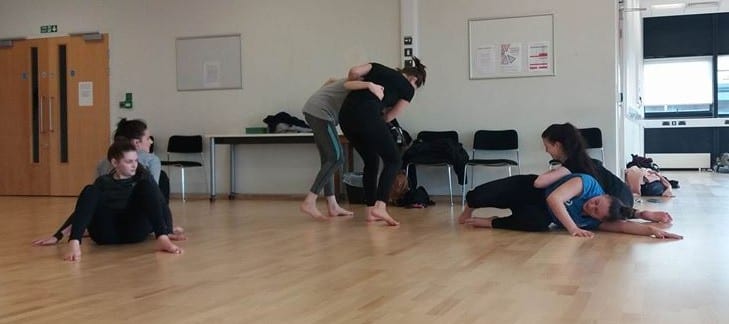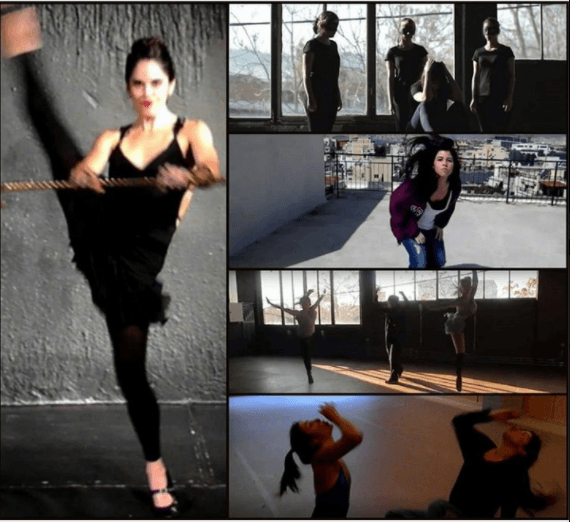The rehearsal:
Today we worked on one of the segments of the choreography where we have a partner work.
The dancers in pairs where pushing each other while reciting the text.
The best thing of all was that after a while they started feeling exhausted. (Yes!) I could see dancers being pushed down, around, on the side, from the back, from the front. I could hear voices from below, from far away, from higher, struggling, deciding, shouting, whispering.
Amazing view!
I am excited because this was the first time that I saw my dancers pushing hard and getting exhausted. What I want them to understand is the “ritual endurance” of the work. I want them to understand that it is okay that their voice is trembling after being pushed and pushing and talking. For a first time, this was exciting. I think we are getting there.
Our next rehearsal will be after Easter and I can’t wait!
The lesson:
It was based on endurance.
Our tutor introduced a task-based private performance for me and my classmate. A very infuriating and enduring one, but also playful and “fun”, as Jamie said.
Before the lesson, I was watching our tutor grabbing bags around, pencils there, “Catherine, help me cut these papers”, then a lipstick, then two oranges and a bag of raisins and “Catherine, do you want to turn on the stage lights?”. And that made me more curious than ever.
With that, we began.
We started sitting on chairs at one corner. In front of us a tweezer, some pencils and the papers I had cut. With the non-dominant hand (!) we grabbed the tweezer (!) with which we grabbed a pencil and papers (!) to write about our experience on endurance pieces. Moving on, with the tweezer, we had to lay down legos on papers that would work as stepping stones. Yes. We stepped on papers with legos (Ouch!). Jamie was fast laying his legos down, but I wanted to have less pain and I had to choose the flatter legos. But this was very time-wasting. After some infuriating minutes, I joined him at the other corner, from where we should return to the middle again to comb each other’s hair and share a lipstick. And then go back again to the other corner, to another table, where the oranges, the raisins and cocktail picks were waiting for us. “Take a cocktail pick, stab a raisin to one end and stab the cocktail pick on the orange on its other end”. Easy? No. With the tweezer. With the non-dominant hand. Jamie was perfect! He did everything really fast and I was struggling. When we finally finished, we had to eat each stabbed raisin (wait for it) , without hands, without teeth, only with the mouth (!) And (!) not chew them, but to just swallow them! I tried to melt them in my mouth as caramels and finished first (yeahy! But no) . I had to help Jamie as well… I thought it would never end.
For our finale we had to go back writing, which means taking the oranges between our two bodies (hands!) with the cocktail picks and step on the legos and arrive at our first seats. There we wrote about our “now” thoughts about endurance, after this experience.
This is a piece of work I would never go and watch or perform or even create. After this experience, I feel that dance choreography is very different from performance art and, well, it needs special talent or not at all to create an interesting performance art work. The repetition can definitely be an element of dance choreography (see Pina Bausch, Anne Teresa De Keersmaeker and more). As Lara Shalson* says: “Repetition is one of the uncomfortable things about theatre”. And she continues by framing it to the “performance of death or pain”. Endurance is another thing. “Practices of endurance are repeatedly key to understanding the relationship between theatre and performance art: endurance is either the limit that distinguishes the two forms or the principal point at which they overlap”. Apparently, no “dance” or “choreography” word was used in this text.
What we did could be a performance of endurance (and I dare say it was). Simultaneously, it was something between theatre and performance art. In practice, I agree with Lara Shalson. The limit at which they overlap cannot be easily distinguished.
Well, this was interesting, though, right?
But that stomach-ache…
*Shalson, L. (2012) On the Endurance of Theatre in Live Art. Contemporary Theatre Review, 22(1) 106-119.



